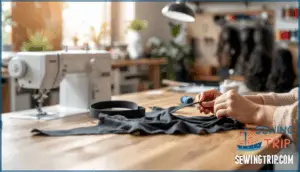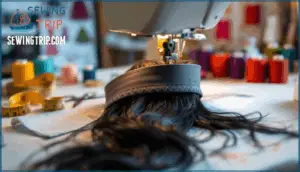This site is supported by our readers. We may earn a commission, at no cost to you, if you purchase through links.
 A loose wig slides back during a shift at work, or lifts awkwardly when you laugh too hard at dinner. You reach up to adjust it—again—and wonder if there’s a better way than adhesive or constant readjustment. There is. A properly sewn elastic band creates the snug, secure fit that transforms a wig from something you wear into something you forget about.
A loose wig slides back during a shift at work, or lifts awkwardly when you laugh too hard at dinner. You reach up to adjust it—again—and wonder if there’s a better way than adhesive or constant readjustment. There is. A properly sewn elastic band creates the snug, secure fit that transforms a wig from something you wear into something you forget about.
The technique requires precision, but once you understand tension, placement, and stitching method, you’ll customize any wig to grip your head like it was built for you alone. This guide walks you through each decision—from measuring your circumference to choosing between hand-sewing and machine work—so you can skip the slip and own your look with confidence.
Table Of Contents
Key Takeaways
- Precise measurements drive secure fit—measure your head circumference, subtract up to 1 inch for tension, and cut with sharp scissors to prevent fraying and ensure the band grips without slipping.
- Placement varies by wig type—frontal wigs need elastic sewn within half an inch of the lace edge, while closure wigs require positioning closer to the crown for balanced grip.
- Hand sewing offers precision for delicate lace, but machine stitching delivers 2-3 times longer durability with failure rates under 5% after 50 washes.
- Regular maintenance extends band life—check stitches every 4-6 weeks, replace elastic when it loses 30% stretch or shows fraying, and avoid heat styling near the band to preserve tension.
How to Measure and Cut Elastic for Wigs
Getting the fit right starts with precision. You need accurate measurements, the right elastic width, and proper tension adjustments to keep your wig secure without slipping or causing discomfort.
Here’s how to measure and cut elastic that works with your head, not against it.
Measuring Head Circumference for a Snug Fit
Before you even think about sewing elastic to your wig, you need to know your exact head circumference—not a guess, not a ballpark number, but the precise measurement that’ll make or break your fit.
Here’s your head size calculation method:
- Wrap a flexible tape measure around your head where the wig will sit
- Record your circumference measurement to the nearest quarter inch
- Subtract up to 1 inch for proper elastic tension
- Mark your final measurement for fit adjustment
- Test your snug fit techniques before cutting
This circumference measurement drives everything that follows in your sewing services approach.
Choosing The Right Elastic Band Width
Once you’ve nailed your head measurement, your next power move is picking the elastic band width that’ll secure that wig in place without fail.
Most custom fit options use 0.75 to 1.5-inch elastic band types for ideal support. Choose narrower widths for lighter wigs and wider bands for heavier units.
Check wig sizing charts before your sewing services begin to match elastic material choice with your cap construction.
Cutting Elastic With Allowance for Tension
Now cut that elastic smart—measure your head circumference, then subtract up to 1 inch to build in the tension you need for a grip that won’t quit. Test your band measurement before you sew—wrap it around your head to confirm the elastic tension feels snug but not crushing.
Your cutting techniques matter here—sharp fabric scissors give clean edges that prevent fraying. Factor in stretch factors when you measure: high-quality elastic retains its tension allowance longer than cheap bands.
Where to Place The Elastic Band on a Wig
Getting the elastic band in the right spot isn’t guesswork—it’s the difference between a wig that stays put and one that slides around all day. The placement changes slightly depending on whether you’re working with a frontal or a closure, and small errors can wreck your entire setup.
Let’s break down exactly where that band needs to go.
Placement for Lace Frontal Vs. Closure Wigs
Lace frontal and closure wigs don’t play by the same rules regarding elastic placement, and getting this wrong means your wig won’t stay put.
For frontal wigs, sew the elastic band directly along the lace edge—no more than half an inch back—to boost elastic band tension and secure fit methods. Closure wigs need placement closer to the crown area where the closure ends.
This wig type comparison matters because lace frontal tips demand edge-hugging precision while closure wig secrets involve anchoring further back for balanced grip.
Edge Distance for Secure and Glueless Fit
The gap between your lace edge and elastic stitching line determines whether your wig stays locked in place or slides around like it’s got somewhere better to be. Here’s how to nail secure fit with the glueless method:
- Stitch 2-3 lines up from the lace edge to fine-tune elastic tension without tearing delicate material
- Leave less than half an inch between lace edge and band placement for maximum grip
- Bend the lace while sewing to prevent damage and guarantee longevity
- Test immediately after stitching to catch gapping or pressure points before wearing
This sew original approach beats adhesives every time.
Common Placement Mistakes to Avoid
Misplaced elastic creates Wig Cap Damage faster than you’d think. Avoid these Elastic Band Errors that wreck your Sew Original work: To prevent common mistakes, understanding wig store near options is essential for a natural appearance.
The following are common mistakes to avoid:
| Mistake | Result | Fix |
|---|---|---|
| Stitching too close to lace edge | 70% risk of tearing and Lace Front Issues | Position 1-2 cm behind ear area |
| Uneven ear-to-ear alignment | 38% experience lateral slippage | Stretch elastic 10-15% during measurement |
| Over-tightening bands | 40% report headaches from Tension Problems | Check every 6-8 weeks, maintain 45-60° sewing angles |
| Wrong attachment on closures | 33% get dome pressure distortion | Place just behind closure base |
| Ignoring cap construction | 54% face edge separation | Match method to wig type—frontal needs different placement than 360 |
Skip these Sewing Mistakes and your glueless installation stays locked down.
How to Sew Elastic Band on a Wig Cap
Once you’ve cut and positioned your elastic band, it’s time to lock it in place. The method you choose and how carefully you work will determine whether your wig stays put or slides around.
Here’s how to attach elastic the right way without wrecking your lace or wasting your effort.
Hand Sewing Vs. Sewing Machine Techniques
Hand sewing and machine stitching each claim territory in the wig game. Hand sewing offers precision for delicate lace and custom fits, while sewing machines deliver speed and durability. Here’s what sets them apart:
- Sewing Speed: Machines complete elastic attachment in minutes versus 20–30 minutes by hand, with professional embroidery machines reaching 900 stitches per minute.
- Stitch Quality: Machine tension creates uniform stitches with under 2% variance, while hand stitching shows 15% more irregularities without experience.
- Thread Tension: Adjustable machine settings prevent over-compression and band fatigue by 25% compared to inconsistent hand tension.
- Labor Costs: Machine sewing cuts production costs by 45% in high-volume settings, though hand methods require minimal quilting equipment investment under $25.
- Durability: Machine-stitched bands last 2–3 times longer, with failure rates under 5% after 50 washes, while hand-sewn bands show 30% higher loosening rates.
When deciding between hand sewing and machine stitching, consider the importance of sewing machine features for your project. Choose based on your volume needs and fabric choice—machines for speed and strength, hand sewing for comfort and adaptability.
Securing Elastic Without Damaging Lace
Securing elastic to delicate lace is where most DIY wig makers either nail the fit or rip their investment to shreds. Bend the lace during stitching to prevent tearing and distribute elastic tension evenly across attachment points.
Use a curved needle for hand sewing or adjust your embroidery machines to low pressure settings for lace protection. Secure attachment without glue keeps your glueless methods intact while maximizing band durability.
Stitch Patterns for Durability
Your stitching pattern is the difference between a wig that survives daily wear and one that falls apart after a few uses. Master these three reinforcement techniques for lockstitch durability:
- Zigzag stitch with controlled tension – prevents elastic stretching past fabric limits
- Double-row straight stitch – distributes pull force across multiple thread lines
- Backstitch at start and end points – locks thread selection in place without unraveling
Check stitch density every 2-3 inches for consistent fabric repair strength.
Adjusting and Testing Wig Fit With Elastic
Once you’ve sewn the elastic band onto your wig, it’s time to see if you nailed the fit.
Testing the placement and tension helps you catch comfort issues before they ruin your day. Here’s what you need to check and adjust to lock in a secure, all-day grip.
Checking for Pressure Points and Comfort
Once you’ve sewn that elastic band in place, slipping the wig on without testing it first is like driving off the lot without checking the brakes—you won’t know there’s a problem until it’s too late. Put it on and wear it for at least 15 minutes. Walk around, tilt your head, and check for any spots where the band digs into your scalp or leaves gaps.
Wearability testing catches pressure points early. Scalp sensitivity varies, so what feels secure to one person might cause discomfort to another. If you notice redness or throbbing anywhere, that band needs adjustment before you commit to daily wear. Hairline protection starts with proper wig comfort during these trial runs.
| Test Area | What to Check For |
|---|---|
| Temples | Excessive tightness or indentation |
| Behind Ears | Rubbing or pinching sensation |
| Nape of Neck | Band sitting flat without rolling |
| Hairline | Natural placement without lifting |
| Overall Fit | Even tension with no slippage |
Adjusting Elastic for Different Head Sizes
Not every head fits the same measurement, and if you’re making wigs for clients or switching between wearers, you’ll need to know how to dial that tension up or down without starting from scratch. The trick is understanding elastic band tension and head size variations.
Measure each person’s circumference, then subtract half an inch to one inch based on how much stretch your elastic has left. Custom fit options depend on band stretch limits—if the elastic’s maxed out, you’ll need to unpick and resize.
Keep your sewing machine maintenance sharp so adjustments stay clean and precise.
Using Adjustable and Removable Bands
If you want to skip the math and tension guesswork every time, adjustable bands are your shortcut to fit-it-and-forget-it adaptability. These bands feature hooks, sliders, or Velcro closures that let you dial in wig security without touching a needle or sewing machine maintenance schedule.
- No more custom fittings for every head size variation
- Swap elastic materials when stretch weakens without re-sewing
- Lock band tension instantly with adjustable straps
Removable designs clip or slide into cap channels, preserving lace and fabric care protocols while delivering bulletproof grip.
Tips for Elastic Band Maintenance and Longevity
Your elastic band won’t last forever, but you can stretch its life with the right care. Regular checks catch problems before your wig starts slipping. Let’s break down what you need to do to keep that band secure and functional.
Routine Checks and Re-Securing Stitches
Check your elastic band every 4 to 6 weeks to catch any loosening before it becomes a real problem. Run your fingers along the stitches during wear monitoring to spot fraying threads or weak points.
If you find slack in the elastic tension, re-stitch immediately using secure fastening techniques. This kind of stitch inspection keeps your wig locked down and prevents sudden slippage when you’re out living your life.
When to Replace Elastic Bands
Elastic Band Replacement timing is crucial for maintaining your wig’s security. Most bands lose around 30% of their stretch in the first 6 to 12 months, so it’s essential to pay attention to Elastic Wear Signs before things fall apart.
Replace your band when you notice:
- Loose fit or unexpected sliding during wear
- Visible fraying, tears, or detachment at the ends
- Stretched-out band measuring 2 cm longer than original
- Reduced tension below 64% recovery from full stretch
Manufacturers recommend swapping out bands every 6 to 12 months for daily wear. Adjustable bands can last up to 18 months, but non-adjustable types need Replacement Frequency checks closer to 8 months.
Think of this like textile maintenance for any high-use fabric—regular care and repair keep your Wig Cap Security intact and your confidence high.
Caring for Wigs With Attached Elastic
Proper maintenance extends the life of your elastic band and keeps your wig secure without constant repairs. Store wigs flat or on a mannequin to avoid crushing the elastic. Wash the wig gently by hand and let the band air-dry completely before storage.
Check stitches every month and re-secure loose threads immediately. Avoid heat styling near the elastic to preserve stretch. This simple daily maintenance protects your investment and keeps tension consistent.
Frequently Asked Questions (FAQs)
Can elastic bands work on 360 lace wigs?
Yes, elastic bands work perfectly on 360 lace wigs. The principle holds true: secure the band close to the lace edge for a snug, glueless fit.
Proper sewing techniques and wig cap construction guarantee hairline security without damaging delicate lace wig materials.
How do elastic bands affect wig styling options?
Elastic bands provide hairline security and styling freedom without limiting your customization options. You can style high ponytails, updos, and sleek-back looks while maintaining a secure fit.
The band type affects adaptability—adjustable bands offer flexibility for changing styles without constant machine repair or re-stitching.
What thread type is best for elastic attachment?
Use polyester thread for elastic attachment. This thread material offers excellent fabric compatibility and elastic durability.
It withstands repeated tension better than cotton, guaranteeing your sewing techniques deliver long-lasting results without breaking under stress.
Can you add elastic to pre-plucked wigs safely?
Pre-plucked wigs are like delicate canvases—you can absolutely add elastic without compromising the hairline if you follow proper fabric care techniques.
Sew your band 2-3 lines behind the plucked edge to protect customization work. Use gentle hand stitching to maintain secure attachment while avoiding lace damage. This preserves your investment.
Do elastic bands interfere with wig combs?
Elastic bands work alongside wig combs without interference when installed correctly. Position the band close to the lace edge while combs stay anchored at temple and nape areas.
This dual-layer secure fit method improves hairline security and band tension control.
Conclusion
A loose thread can unravel an entire garment—and an unsecured wig unravels confidence the same way. Learning how to sew elastic band on wig transforms that fragile connection into something unshakable.
You’ve measured, positioned, and stitched with intention. Now the wig moves with you, not against you. No more discreet adjustments or second-guessing your appearance. You’ve taken control of the fit, and in doing so, you’ve reclaimed the freedom to live without distraction. That’s not just craftsmanship—it’s liberation.
- https://www.youtube.com/watch?v=SPIdPQ56rjY
- https://www.harfington.com/products/p-1319742
- https://www.keswigs.com/blogs/guides/how-long-do-human-hair-wigs-last
- https://www.sphinxhair.com/blogs/faq/how-long-do-wigs-and-bundles-last
- https://www.hairalicious.com/everything-you-need-to-know-about-real-hair-wigs/












